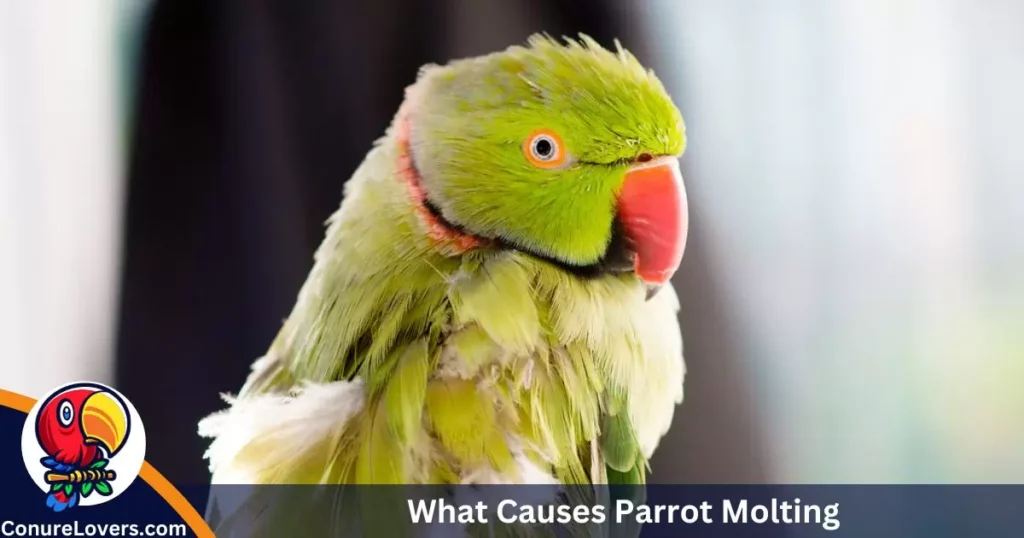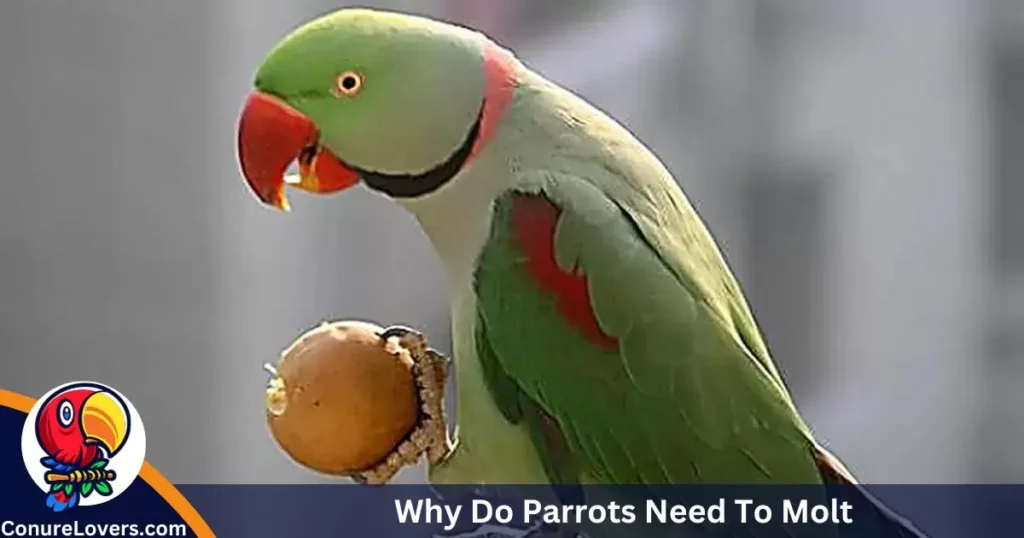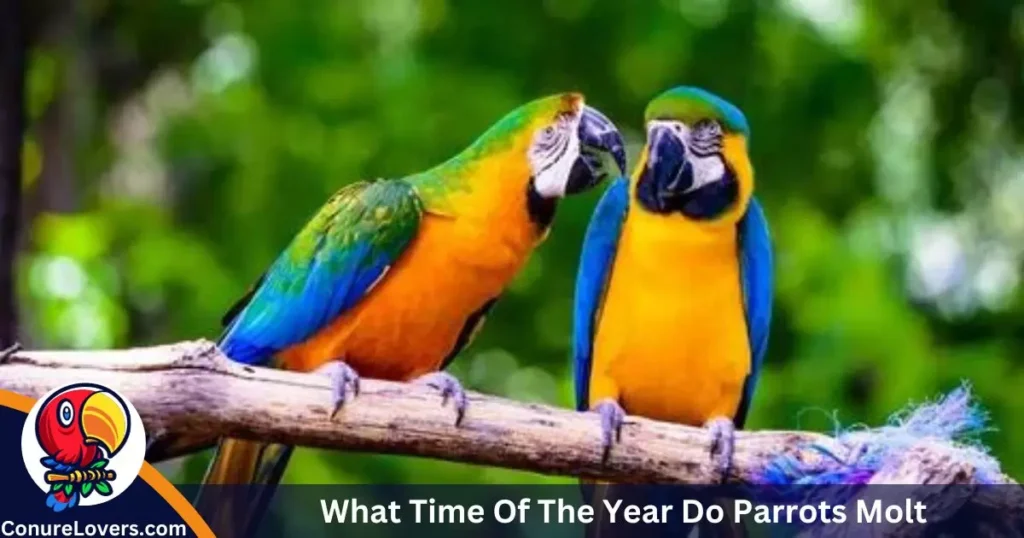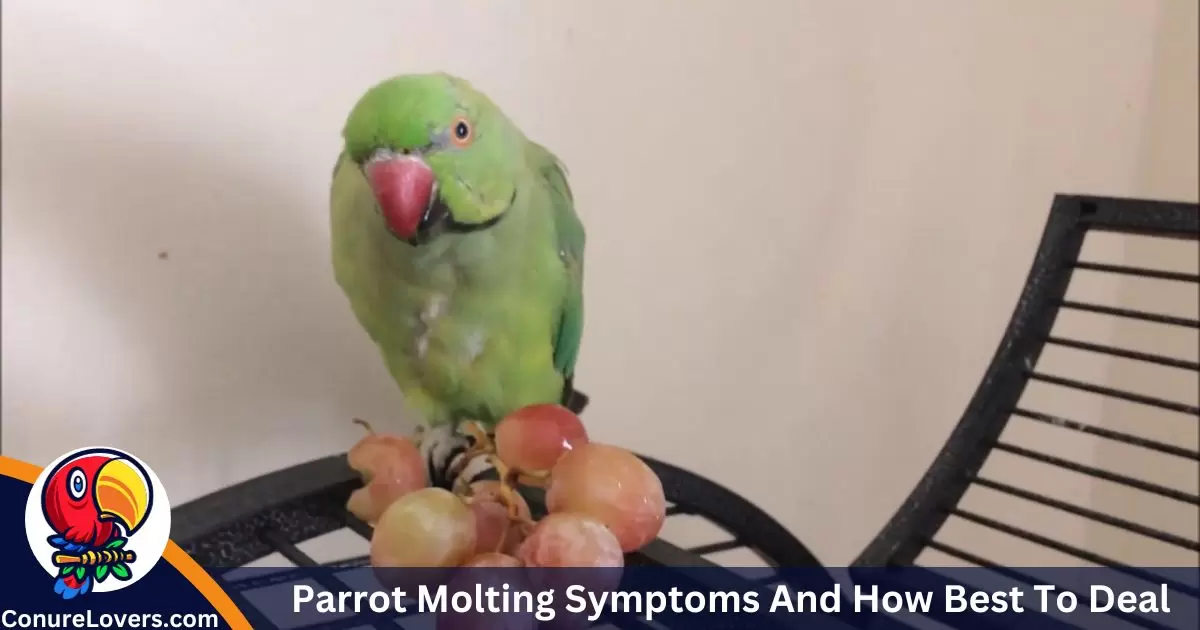Parrot molting symptoms may include irritability, defensive behavior, slight lethargy, and the development of bald patches.
If you’re a new parrot owner and freak out when you see a bunch of feathers scattered around your feathered friend’s home, chill out! It’s probably just molting, a natural thing. During this feather-shedding phase, your bird might get a bit itchy, and that’s where you come in – give them a hand in feeling comfy.
But wait, don’t rule out the possibility of those fallen feathers being a result of your parrot going all destructo-mode. This article spills the beans on parrot molting – the symptoms, what it means for your bird, and how to tell it apart from a feathery demolition derby.
Here are signs of molting in birds that you should watch for:
- Increased aggressiveness towards other birds or even you.
- Squawking and moodiness.
- Loss of appetite.
- Many feathers are scattered in the bird’s cage.
- Your bird appears tired and sleeps more than usual.
What is Molting?
Molting is like a wardrobe upgrade for birds – they shed old feathers to make room for shiny new ones, all for better flight and impressing potential bird baes. For parrots, this feather makeover happens about once or twice a year, and it’s a must-do for them to sport that fresh plumage.
Now, they’re not doing a full-on strip show. Molting is a gradual affair, starting with the wings, then the body, and finally, the tail feathers. But hold up – they’re not grounding themselves during this makeover. Nope, they’re smart about it, molting a few feathers at a time so they can still catch some air.
Here’s the twist: molting doesn’t always mean a complete feather overhaul. Sometimes it’s just a touch-up – certain feathers getting the makeover treatment, a.k.a. partial molting. So, no, your parrot won’t turn into a featherless wonder during molting season.
Now, why does molting happen? Blame it on the light – natural sunlight or its artificial cousin. Parrots hooked to modern windows might get confused during this fashion season. Those windows don’t quite mimic the real deal, and that’s why your pet parrot might be strutting its molt at odd times of the year.
So there you have it – molting, the seasonal fashion show for our feathered friends!
Read Also: Apple Cider Vinegar Benefits For Parrots
What Causes Parrot Molting?

Molting is all about following the groove of nature’s rhythm. It’s a regular thing that, just like breeding and migratory habits, happens naturally throughout the year. Out in the wild, birds are savvy – they avoid molting during the high-energy seasons of breeding and migration. It’s like they’ve got a built-in energy-saving mode.
Now, for our pals in captivity, like pet parrots living the indoor life, things can get a bit wonky. Their natural rhythms might hit a snag, and voila, you’ve got molting at unexpected times of the year.
It’s like nature’s way of saying, “Hey, I’ve got a plan, but indoor living might need a little adjustment.” So, if your feathered friend decides to molt when you least expect it, blame it on the indoor vibes messing with their natural birdy calendar.
How Do Parrots Molt?
Absolutely, here’s the bolded version for emphasis:
Nature is a total showstopper, especially when it comes to parrots and their jaw-dropping molting techniques.
Check this out – when a feather on the left side of a parrot’s body takes a leap, its counterpart on the right side isn’t far behind. It’s like a synchronized dance of falling feathers! Why? Because this symmetrical molt keeps our flying friends balanced during their mid-air adventures. Imagine if all the feathers on one side decided to bail at once – not the smoothest flight, right?
Now, every feather on a bird is a VIP in the world of flight dynamics. If too many feathers on one side decide to pull a disappearing act simultaneously, our birdie might struggle to soar through the skies with style.
And here’s the scoop on the sequence – birds have a molting order. Some feathers drop in early, others fashionably late. The flight feathers and tail feathers take the lead in this molting parade since they’re easy to spot. But what about the body feathers? Those are a bit trickier to keep tabs on, so the sequence might be a bit mysterious.
But here’s a fun fact – the fancy feathers that parrots flaunt during courtship? They’re like the VIPs of molting, saving their grand exit for the grand finale. So, when it comes to molting, our feathered friends have got this well-orchestrated performance going on!
Why Do Parrots Need To Molt?

Parrots go through molting because, just like any other bird, their feathers wear out. Flying efficiently requires top-notch feathers, and in the daily hustle, parrots might brush against stuff, get into scuffles, or groom their own feathers. Over time, those feathers can get a bit worse for wear, making it tough for our feathered pals to soar. So, they molt – swapping out the worn-out feathers for fresh ones. It’s a must for keeping them airborne and cozy.
Unlike our hair or nails, feathers don’t keep growing forever. They hit a certain length and then call it quits. That’s why molting is essential – a feather makeover to replace the old with the new, ensuring they’re always ready for action.
Now, birds, including parrots, molt not just for flight finesse but also for the dating scene. Some birds spruce up with different-colored feathers during mating season to catch the eye of potential partners. After the romance season, they go back to their usual look. Others molt for a bit of stealth – blending in with different landscapes and seasons, like going from dry rocks in summer to snowy white in winter.
As for parrots, it’s a bit of a mystery. While we know they molt for feather renewal and flight, their fashion choices or camouflage tricks are still up in the air. These colorful flyers might just be keeping their molt secrets close to their chests!
How Do I Know If My Parrot Is Molting?
Spotting parrot molting is a breeze – just look around their cage or perch, and if you see a feather fiesta on the floor, your bird is in molt mode. While the occasional feather drop is normal, an unusual flurry of feathers on the ground is a telltale sign that your parrot is going through a molt.
Now, your feathery friend might not be great at verbalizing their feelings, but there are other signs that clue you in on their molting journey. Recognizing these symptoms helps you understand what your parrot is dealing with and allows you to ease any discomfort they might be feeling – discomfort that could easily be mistaken for sickness.
Keep an eye out for these signals to be your parrot’s molt ally!
Irritability:
You might catch your bird doing a feather scrub dance against surfaces – it’s not a dance move, though. Molting tends to be itchy and uncomfortable for your parrot.
Defensive Behavior or “Moodiness”:
Blame it on the irritation – your parrot might turn into a little feathery ninja. More object biting or even a cheeky lunge or nip at you could be signs of their molting mood.
Slight Lethargy:
Molting is like a feather workout, and it takes energy. Your parrot might be less bouncy than usual, opting for some solo time or extra naps. On the flip side, some owners report a molting snuggle fest – their parrots seeking comfort and neck scratches to soothe the itch!
Bald Patches:
In the molting Olympics, some birds go for gold, shedding more feathers than the usual routine. Result? Bald patches or spots with sparse feathers (check out the pic below, around the neck area). Don’t fret; it’s normal, as long as those sparse spots fill in with fresh feathers later.
Appearance of “Pins” or White, Prickly-looking Growths:
Ever seen tiny white spikes on your parrot’s head? Those are pin feathers, signaling the growth of new feathers from the molting process. It’s like nature’s way of saying, “New feathers are on the way!”
FAGs
What Time Of The Year Do Parrots Molt?

Molting Schedule:
Parrots typically molt once or twice a year, usually doing a feather makeover in the fall and spring. However, the exact timing varies among species. Some parrots go for an early molt, while others prefer a later schedule. The big guys, like larger parrot species, might be more laid-back, molting once every two years. Their molting marathon takes about six months, kicking off in the fall.
Speedy Molt for Smaller Birds:
Now, the little ones, such as cockatiels, are like the sprinters of the molting world. They might molt up to three times a year because their feather revamp is a quicker process. What sets their molt clock? It’s a mix of nutrition, temperature, migration (or lack of it), the overall health of the parrot, and whether they’re in the mood for some birdy romance.
Seasonal Molting Magic:
Molting isn’t just about feathers; it’s a seasonal show. The change in day length, thanks to shifting seasons, triggers molting and sets the stage for other birdy activities like breeding. If you’re in the US, expect your parrot to put on its molt performance around September, October, and November.
Wild vs. Pet Parrots:
Wild parrots have a molting rhythm synced with natural sunlight. But for our indoor buddies, the molt clock can go a bit haywire. Pet parrots, not getting their daily dose of sunlight, might molt at odd times. Their feather-shedding schedule is influenced by temperature and isn’t as predictable throughout the year.
How Long Does A Parrot Molt Last?
Molt Duration:
The molting marathon is a bit like a feather spa day, but the duration varies for our feathery friends. Smaller parrots, the quick-change artists, might molt up to three times a year, wrapping up their feather makeover in about one to two months.
Larger Parrots:
Now, the big guys, the larger parrots, are like the slow-motion version of the molt show. Their feather transformation takes a leisurely six months. So, they opt for the chill approach, molting only once every two years. Makes sense – those bigger feathers need some extra molting TLC.
Living with the Molting Mess:
For parrot owners, molting equals a bit of mess. Feathers everywhere! Especially with the larger parrots, you’ll find yourself in a feathery situation. That’s why it’s a good idea to play the cleanup game more often. Regularly sprucing up the area helps get rid of those shed feathers and dander, keeping your parrot pals and your living space healthy and happy.
Is Molting Painful For Parrots?

Painless Molting:
Good news for our feathered buddies – natural molting is a breeze, and it doesn’t cause any discomfort. You might spot a half-loosened feather hanging out of your bird’s plumage, and they’ll casually pluck it away with their beaks, no drama. When feathers naturally fall out, it’s a painless process for our parrot pals.
The Itchy Side of New Feathers:
Now, the not-so-fun part? Growing new feathers. As your parrot gears up for a feather makeover, they sprout these things called pin feathers. These little guys are super sensitive, and if you touch them, your parrot might feel a bit of itchiness or discomfort. So, while molting itself is a walk in the park, the arrival of those new feathers can be a tad irritating for our bird buddies.
Just remember, a little itch during the molt is a small price to pay for those fabulous, fresh feathers!
Is Molting Stressful For Parrots?
Molting Struggles:
Let’s be real – molting is no parrot party. It’s like a major makeover project, and growing a bunch of new feathers can be downright stressful and exhausting for our feathered pals. So, if your usually lively parrot suddenly seems less active, it’s probably feeling the molting blues.
Feather Artistry:
Growing new feathers is no walk in the park. It’s like your parrot is creating a masterpiece with each feather – intricate and complex. Sure, it might seem like your bird is having a dramatic mood swing, but in reality, it’s dealing with some emotional and physical stress. Cut them some slack, offer a bit of support, and be their molting cheerleader when you can. They’ll appreciate the TLC during this feathered challenge.
How Can I Help A Molting Parrot?
1. Boost Protein Intake:
Feathers are protein-packed wonders, and your molting parrot needs a protein boost. Consider adding small bits of fully boiled chicken egg to their diet – it’s a feather-friendly protein source. Just don’t overdo it; moderation is key.
2. More Baths or Showers:
After feathers fall out, new ones sprout with a protective waxy casing. Imagine a bunch of tiny pins poking out – not the comfiest feeling! Ramp up the baths or showers for your parrot to soothe their skin, soften those pins, and make the whole feather-coming-out process less prickly.
3. Sunlight Exposure:
Give your feathered friend some natural sunlight. Aim for at least half an hour a week with direct sun rays – not through a window. Keep an eye on them in hot climates to prevent overheating. Even wild parrots enjoy a bit of sun-filtered through foliage, so find the right balance.
4. Socialization and Understanding:
Parrots can get a bit moody during molting, so offer some social time to reduce stress. Understand their crankiness – it’s like a feathery version of a bad hair day. Be patient, even if they get a bit nippy, and give them the space they need to rest and recharge.
5. Maintain Warmth:
Featherless or not, parrots can feel the chill during molting. Keep their environment cozy by avoiding drafts, but don’t turn the room into a sauna – find that comfy temperature sweet spot.
6. Assistance with Preening:
Pin feathers, the developing feathers, need a bit of help to shed their waxy casing. Lone parrots might not have a buddy to assist in those tricky spots. If your parrot is up for it, gently massage the feathers with your fingers. But remember, never tug at the pins – that’s a feather faux pas. This preening helps bring comfort and relief to your bird during molting.
Can Molting Parrots Fly?
Flight during Molting:
In the grand molting spectacle, parrots maintain their ability to fly because they don’t go for the all-or-nothing feather shed. Instead, it’s a gradual process, ensuring they keep their airborne finesse. Nature’s smart move – it allows them to zip around, whether escaping predators or seeking out their next meal.
Exceptions to the Rule:
However, in situations where parrots face severe molting, driven by deficiencies, behavioral plucking, or health issues, things can take a nosedive. Excessive feather loss becomes a hurdle, potentially impairing their flying skills. In such cases, the usual grace in flight might be compromised. A reminder that a parrot’s feathered prowess depends on a healthy molting process.
Do Parrots Bleed When They Molt?

Parrots typically don’t bleed during molting, but there are exceptions, especially when their feathers break in the process. If a growing feather still has a blood supply, it’s called a blood feather. These feathers pose a risk of significant bleeding if damaged, as the broken shaft acts like a straw, allowing blood to flow freely. Excessive blood loss from broken blood feathers can even lead to a parrot’s death.
Handling Broken Blood Feathers – Quick Guide:
- Emergency Mode: Treat it as an emergency, but keep your cool. Having a parrot first aid kit with styptic gel or other clotting aids on hand is a lifesaver to stop the bleeding.
- Swift Removal: Broken blood feathers need quick and skillful removal with tweezers, pulling them out in the same direction as their growth. Avoid twisting, as it may worsen the break. If the feather breaks too short, extracting the rest becomes tricky, and a vet visit may be necessary.
- Stop the Bleeding: After feather removal, apply firm pressure on the wound to halt the bleeding. Usually, the bleeding stops quite promptly after removing the blood feather.
- Clotting Aid: If bleeding persists, apply styptic gel or other bird-safe clotting aids to stop the flow.
- Safe Recovery: Allow your bird to rest in a secure area, preferably in its covered cage. Immediate and thorough cleaning of blood-stained feathers isn’t a priority, as it might stress your bird. A general wipe is enough – let your parrot recover from the shock.
- Vet Consultation: If bleeding persists and you can’t stop it promptly, seek immediate vet assistance. Delay could be fatal for your bird.
Final notes
- Natural Feather Shedding: Molting is a natural feat for parrots – a feather shedding extravaganza they must endure. While you can’t speed up their feather regrowth, your support can make a world of difference during this process.
- Affection and Company: Beyond nutrients and sunlight, your parrot craves your affection and companionship during molting. Your presence is a comfort, and a little extra love goes a long way in making the molting journey more bearable.
- Playtime with Toys: Introduce toys into your parrot’s world. Playtime not only brings joy but also serves as a welcome distraction from the itchiness and discomfort of molting. Toys release happy hormones, lifting your parrot’s spirits even in less-than-ideal conditions.
- Monitor Molting Patterns: Keep an eye on your parrot’s molting patterns. If things seem irregular or off, take action. Consult a trained avian veterinarian if you notice abnormal molting times or peculiar feather growth. The vet can assess if any treatments or interventions are needed to ensure your parrot’s well-being.
Remember, a happy parrot is a resilient parrot, even in the midst of molting woes!

I’m Dariel Campbell, your Conure Care Pal from “Conure Lovers.” Join me in creating a cozy and loving home for your conure. I’ll share friendly tips to make your conure care journey a delightful experience!











